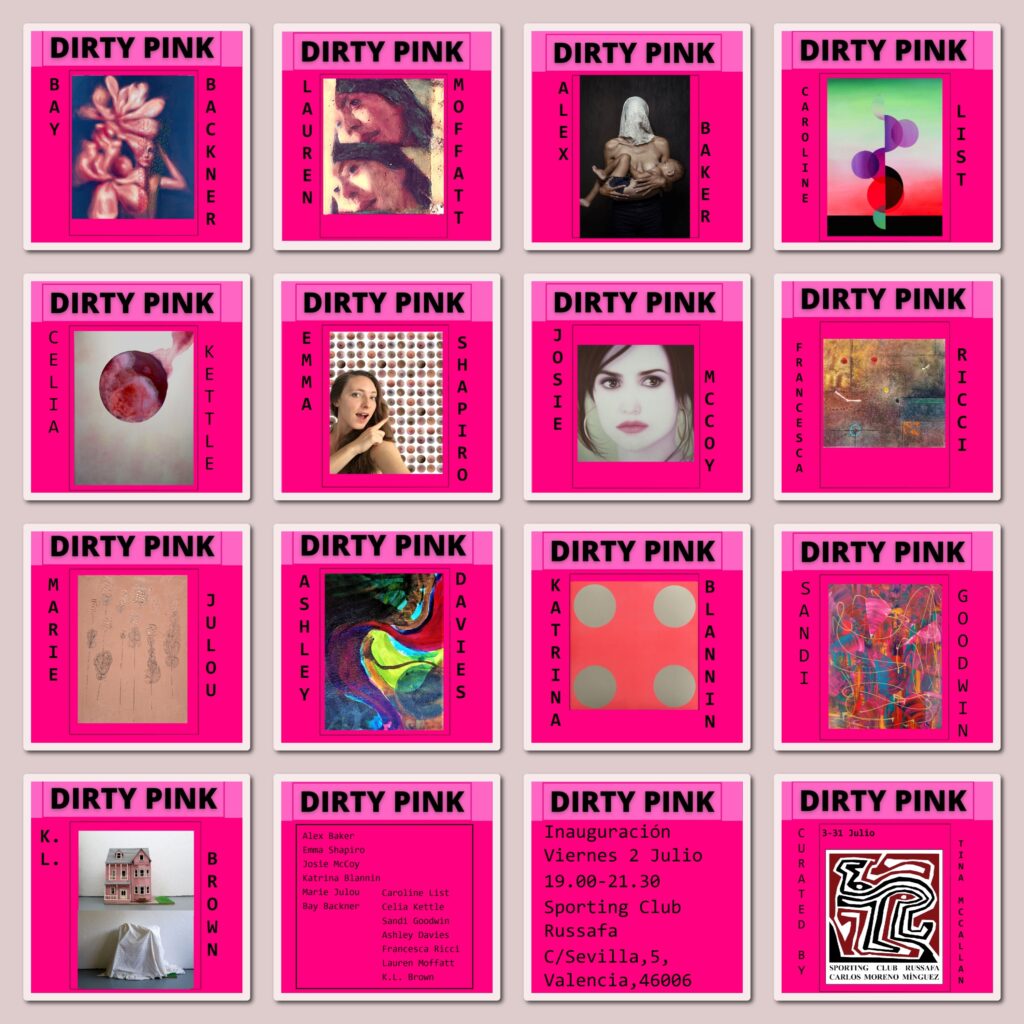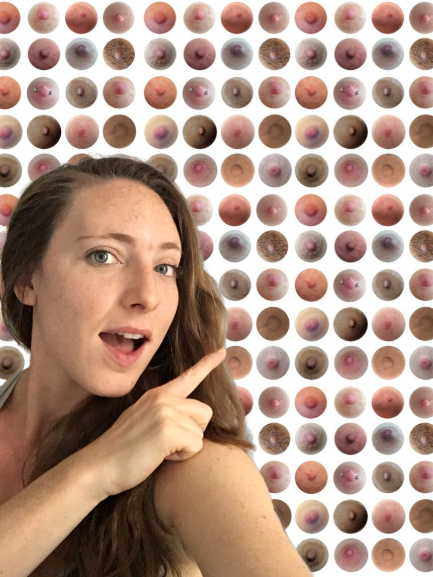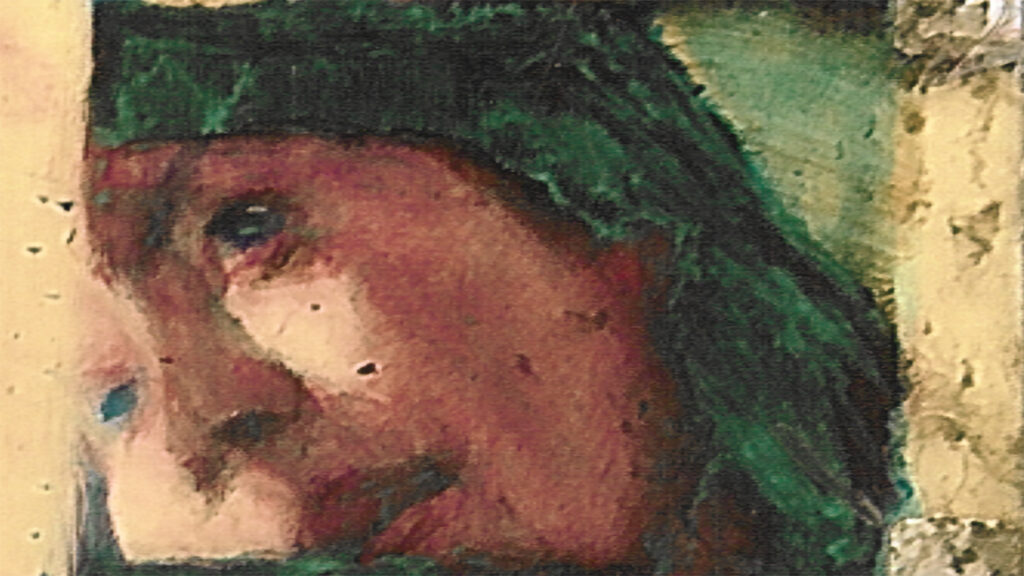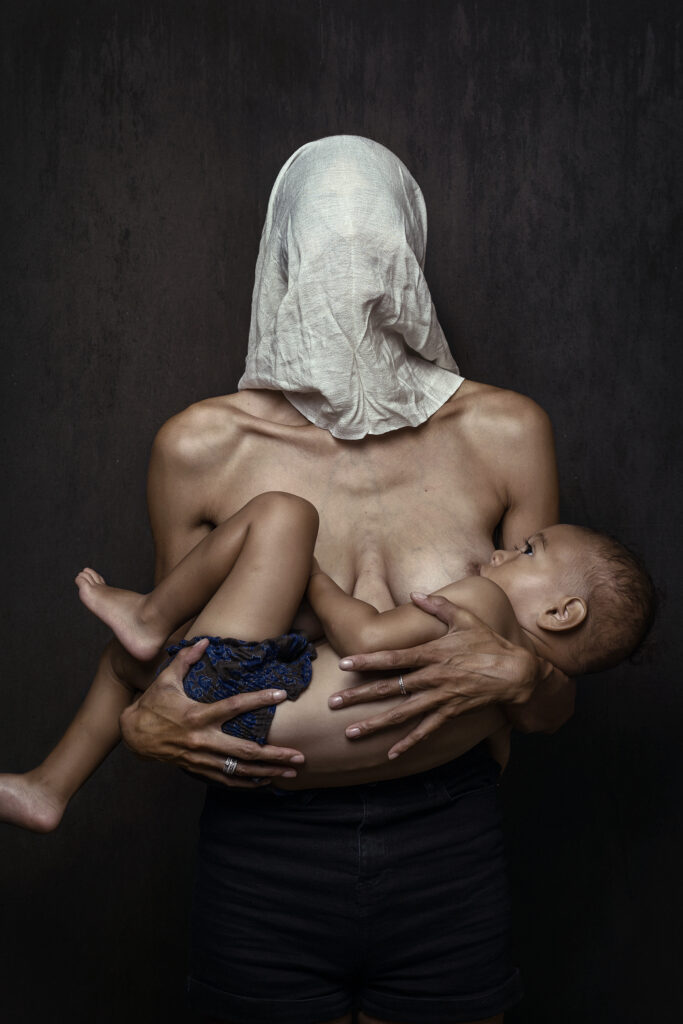
Time was, pink was associated with femininity, the kitsch and bubblegum-pop; now, a new exhibition in Ruzafa shows how it has developed into a more powerful totem for different groups. Laura Menéndez spoke to curator Tina McCallan…
Tina McCallan presents a new exhibition she is curating here in Ruzafa, Valencia. The title Dirty Pink relates to McCallan’s obsession “with the colour and a certain punk attitude embodied in the artwork or artist,” says McCallan. Irreverent, thought-provoking and seductive, it promises to be; some 13 artists exhibit their work in the show, which opens on Friday 2 July at 7pm at Sporting Club Russafa.
The exhibition shows the results of 13 international artists’ responses, either direct or indirect, to being asked about the context and attitude of the colour pink. “Over the centuries, society’s perception of the colour has changed from it being considered feminine, erotic, kitsch, sophisticated and transgressive,” says McCallan. ”Nowadays it’s taking on a more political stance,” she adds.
According to Valerie Steele, the author of Pink: The History Of A Punk, Pretty, Powerful Colour, the “150-year-old notion of pink as synonymous with fragile femininity is being challenged. People have taken new stances towards it,” says Steele. “We’ve seen the rise of millennial pink as an ‘It’ hue, but also its appropriation by feminists around the world as a powerful, socio-political mark,” she continues.
Many of the 13 artists have studios in Valencia but have relocated from the US, the UK, Australia, Germany, and Italy, bringing into the focus the new internationality that is becoming the hallmark of the Valencian art scene. McCallan will also be showing three London-based artists – Katrina Blannin, who writes and teaches for the London-based painting school/ magazine Turps Banana, Caroline List, who teaches at St Martin’s College of Art and Ashley Davies, who has taught at Somerset House, London – participating in the exhibition.
Says McCallan: “In Western culture, the colour pink has often been associated with little girls, the feminine and a lack of seriousness so as a female painter wanting to use pink in my paintings at art school, I often encountered a certain disapproval.
“Even now it feels like a guilty pleasure,” she adds, saying, “I decided to explore these issues by curating this exhibition.”
McCallan says that, by appropriating the colour– “which fascinates and delights in equal measure” – it has given her permission to use it in her paintings.

“The work in the show either openly embraces the colour pink or embodies the pink attitude,” McCall says, adding: “We all remember the pink pussy hats that women made to protest against Trump.”
Despite the exhibition title, however, pink is not the only topic. Questions posed by the exhibition include:
- Can gender also be a performance?
- Is there such a thing as an exclsuively feminine or feminist aesthetic?
Many of the artists have also had a dialogue through the art collective Colonia Roma, a group set up by Bay Backner (organiser of ArtWalk VLC) to connect and support artists. It’s a unique opportunity to gain some insight into the art being made here in Valencia.
“The fragmented and politicised female body” is dealt with in Emma Shapiro’s Cuerpas, video series. Using old life-modelling photos of herself, she cuts them up and reassembles them, mixing heads, torsos, and legs in a jumble, then films them in an animated dance that resembles scientific flicker tests or contemporary dance.
Says Shapiro, “With Cuerpas, I am investigating who I remember myself to be, and how I adapt to new circumstances and ‘lives’ by twisting this concept of who I ‘am’ into them. But as I move farther from this person I identify as, who is it that I am bringing into my present? While I hold on to my identity as a touchstone, I am reminded that even who I believe myself to be distorts and changes over time”.
The short black-and-white film, which will be shown in a loop, shows her collaged body, twisting and forming again and again in the style of a surrealist drawing game, like an exquisite corpse.
In her Nipple Wall, in a bid to challenge the censorship around the female nipple, visitors will be able to take a selfie in front of wallpaper printed with the nipples of hundreds of women. Originally from the US, Emma is an art activist who is using her own body in her work to change attitudes to the female body and is about to release a limited-edition work with the Liminal Gallery, here in Valencia.
Another film loop is by Lauren Moffatt, who is known for her current work integrating analogue and organic materials into virtual environments. In this film loop from 2004 entitled Rose, coloured, the artist has painted each frame using oil paint directly onto blank super 16mm film, a series of 240 miniature portraits of a woman named Rose, each one measuring 12mm x 6mm. This controlled gesture unravels as the images are blown up as a projection, revealing the uneven texture of the paint, the traces of the brush on the celluloid, as well as dust and cracks in the film material – caused by the acid in the oil paint – that have been mended with splicing tape. The attempt at intricate uniformity ultimately fails, creating a jittering, turbulent sequence that reflects on impermanence and the conflicting forces of restraint and chaos.

The influence of surrealism has seeped into the next work. Partly inspired by Magritte’s The Lovers ( who kiss while their heads are enshrouded in white cloth and references the suicide of the artist’s mother who drowned and was fished out of the river with her nightdress over her head), as well as the judgementalism around women breastfeeding in public, particularly referencing the KLM scandal, Alex Baker’s graphically beautiful photos entitled, This Is Motherhood” deal with his topic in a striking way.
Baker says, ”I wanted to explore ideas around judgement, shame and embarrassment about breastfeeding in public and for extended periods of time as well as touch on the idea that when the baby is born the mother becomes invisible, it becomes all about the baby”. These photos have an incredible impact as the women stand, with heads enshrouded obscuring their identity while nourishing their child.
Francesca Ricci comments on birth in her subtly layered paintings entitled In Utero. They are peppered with mysterious signs and symbols referring to the experience of maternity as an almost alchemical process. A fan of Carl Jung, she says, “The diptych In Utero is from the series Fondali, fondale’ in Italian meaning both ‘seabed’ and ‘backdrop’, suggesting at the same time a horizontal surface, where layers of experience and collective memory sediment, and a vertical one, the backdrop against which we act out of life”. Her work is a fascinating lexicon of signs with each one referring to a particular emotion.
Moving from the internal to the external, beauty, self-image, and identity are tackled in the work of Bay Backner with the flesh-coloured floral forms in Allegory, threatening to obliterate the figure. Painted alla prima (wet into wet), these portraits are based on photos of the artist, the surfaces of which are then decorated with embroidered patterns. She says, “the flowers represent these overwhelming cultural expectations that we women have and yet they are so much a part of us. These flowers are not separate from us, they exert pressure or weight. The forms are ambiguous, but the structures can also be grown into and be sources of power.”
Ideas about Modernism and the surface perfection of the blank canvas are physically attacked and slightly mocked in the works by Marie Julou with glitter-sprinkled, scratched and pencil doodled oil paint. In Glitter Circle and Sgraffiti Doodle 1, she mixes both “low” and “high” art materials on amateur canvases and, with tongue firmly in cheek, she seeks to challenge the modernist patriarchal hegemony.
Says Julou, “Using amateur canvases and glitter bursts the bubble of modernist pomposity that often surrounds abstract expressionist painting. Having said that I’m not painting ironically but am interested in the meditative quality of painting, in layers, covering things up and revealing them. Each painting has its own archaeology with its history of colours and marks buried beneath the final layer.”
The theme of abstraction is continued in Sandi Goodwin’s Splash of Pink, the energetic gestural strokes of colour almost burst out of the frame as colours melt into each other, while in Celia Kettle’s Shot through the Heart, the circle operates as a metaphor for the individual with watery spheres breaking out of their boundaries and spilling out onto the white canvas like blood stains.

A more mathematical perfection can be seen in the abstract works of Katrina Blannin who, in Maximillian #101 and 102, bases her abstract works on the mathematical formulas of the Old Masters. Having just graduated with a PhD in painting from Worcester University, she says, “The process of experimenting with simple systems, as well as palindromic and isochromatic structures, aims to produce paintings with a logical clarity, both spatial and material in character. The prints in the show seem to hum with their subtle colour combinations.
As does the colour perfection of Caroline List’s work in, for example, Chromascape Scarlet Green, where she uses complimentary colour gradients to refer to Modernist abstraction and representational languages. She says, “Illusory horizons are explored through gradient colour shifts, form and light. This inquiry into colour and illusory space sets up a conversation within my paintings, informed by both colours observed within the natural world and the physics of colour.”
Illusory perfection can be seen in the iridescent skin of Raimunda IV by Josie McCoy whose uncannily realistic portraits of female celebrities give the viewer a sense of the unheimlich (uncanny or weird). Says McCoy, “When we watch movies, the faces become part of our visual culture, they form a vernacular deeply embedded in our psyche. In my paintings I aim to create an almost mask-like surreal beauty allowing us to project our deepest desires onto these characters, using them as avatars to momentarily enter another reality.”
Taking us back to our childhood, KL Brown shows us Sophie’s Choice, a photographic work of a discarded doll’s house, which aims to question the social structures around us and their effect on our psychological state while Ashley Davies’s painting hovers between abstraction and figuration in a liminal space partly influenced by her visual impairment which questions the certainty of perception through colour, shape, and form.
DIRTY PINK opens to the public on Friday 2 July, 7pm until 9:30pm, and will continue until 31 July. There will be a continuous projection of Emma Shapiro’s films at the opening starting at 7pm. Opening times: Saturday 3/10/17/24/ July, 11am–2pm; or by appointment – call Tina McCallan on 652 250 785, admission, free
There will be an artists talk moderated by Banafshe Hejazi on Saturday 10th July at 12.00 and a series of workshops connected to the exhibition to be confirmed.
Sporting Club Russafa, Carrer de Sevilla, 5, 46004 València; 606 22 28 78; www.sportingclubrussafa.com
Tina McCallan and Laura Menéndez
Thanks for sharing. I read many of your blog posts, cool, your blog is very good.
Your article helped me a lot, is there any more related content? Thanks!
Thank you for your interest.emedicalsci
Thank you for your interest.scholarlypub
Thank you for your interest.eclinicalcentral
Thank you for your interest.environmentjournals
Thank you for your interest.pulsusjournal
Thank you for your interest.wikaya
Thank you for your interest.fadhila
Thank you for your interest.conso-med
Thank you for your interest.thebestofgreenbay
Thank you for your interest.thebestofmidland
Thank you for your interest.thebestofsacramento
experience and quality thank you.richtour
experience and quality thank you.united-royal
experience and quality thank you.hearproof
Thank you for your interest.outsourcedmarketingpros
Thank you for your interest.pdirealty
Thank you for your interest.plasmapreen
Thank you for your interest.pocketchangeduo
Thank you for your interest.planetlimony
Thank you for your interest.pdcfundraising
Thank you for your interest.power-tran
Thank you for your interest.prefplastics
Thank you for your interest.printersupplygiant
Thank you for your interest.quimicolsa
Thank you for your interest.paulyboybrand
Thank you for your interest.raybomarine
experience and quality thank you.tavgrupp
experience and quality thank you.tommiriiulid
Thank you for your interest.rcollision
Thank you for your interest.regionalsigns
Thank you for your interest.reinforcedplasticslab
Thank you for your interest.relisandroth
Thank you for your interest.repelrestoration
experience and quality thank you.easyketodietsuccess
experience and quality thank you.dishaairwaysenterprise
Thank you for your interest.recycledrubberpavers
Thank you for your interest.rmkdistributors
Thank you for your interest.robertwitcomblandscape
Thank you for your interest.rohanengineeringpc
Thank you for your interest.rockypointbarbershop
Thank you for your interest.rollnroaster
Thank you for your interest.rosanneebner
Thank you for your interest.rcollision
Thank you for your interest.royalbakersdist
experience and quality thank you.holycowindian
experience and quality thank you.gavinburke
experience and quality thank you.aerocbt
Thank you for your interest.rottoconsultants
Thank you for your interest.royalburton
Thank you for your interest.royscottmarine
Thank you for your interest.reliablegeneralagency
Thank you for your interest.sandinghouse
Thank you for your interest.scbox
Thank you for your interest.royalroseinc
Thank you for your interest.royalroseappliances
Thank you for your interest.rrappliance
Thank you for your interest.scmanndds
Thank you for your interest.rrappliances
Thank you for your interest.sealfiberglass
experience and quality thank you.boban
Thank you for your interest.plasticsrecycling
Thank you for your interest.projectbinder
Thank you for your interest.tlc
Thank you for your interest.trendcreditcorp
Thank you for your interest.unitycreationsltd
Thank you for your interest.dawnnhough
Thank you for your interest.monarchengraving
I really like looking through an article that can make men and women think. Also, thank you for permitting me to comment.
Your point of view caught my eye and was very interesting. Thanks. I have a question for you.
I must thank you for the efforts you have put in penning this website. I’m hoping to check out the same high-grade content from you later on as well. In truth, your creative writing abilities has encouraged me to get my very own website now 😉
En iyi Online Casino
What’s Going down i am new to this, I stumbled upon this I have discovered It absolutely useful and ithas helped me out loads. I am hoping to give a contribution & assist other users likeits aided me. Good job.
This will serve them nicely during instruction, as they are not solely uncovered to grueling physical assessments, but are additionally trained in the tradition, language, customs, geography and traditions of the realm that will ultimately function their Areas of Operation (AO).S.
Your point of view caught my eye and was very interesting. Thanks. I have a question for you.
Our skillset in cyber finance and electronic payments means we’re perfectly equipped to tackle your QIWI wallet issues.Be assured, we utilize the latest techniques and keep up with the newestfraud prevention strategies.For those who’ve been hit with unauthorized transactions ortechnical glitches that caused a loss of funds, our team isready to assist.
Your point of view caught my eye and was very interesting. Thanks. I have a question for you.
Explore the ranked best online casinos of 2025. Compare bonuses, game selections, and trustworthiness of top platforms for secure and rewarding gameplaycrypto casino.
I love looking through an article that can make men and women think. Also, thanks for permitting me to comment.
Thank you for helping out, fantastic info. “You must do the things you think you cannot do.” by Eleanor Roosevelt.
Very nice write-up. I definitely love this site. Stick with it!
Thank you for your shening. I am worried that I lack creative ideas. It is your enticle that makes me full of hope. Thank you. But, I have a question, can you help me?
There’s definately a lot to know about this subject. I love all the points you made.
Regardless of your preparation method, you’ll want to make certain to chop the stem off your tomatoes and cross-reduce the other facet of the tomatoes — this will assist evenly cook the tomato and make the skin simpler to peel off.
Good day! Do you know if they make any plugins to safeguard against hackers? I’m kinda paranoid about losing everything I’ve worked hard on. Any tips?
Hello, I think your website might be having browser compatibility issues.When I look at your blog in Chrome, it looks fine but when opening in Internet Explorer, it hassome overlapping. I just wanted to give you a quick heads up!Other then that, great blog!
Thank you for your sharing. I am worried that I lack creative ideas. It is your article that makes me full of hope. Thank you. But, I have a question, can you help me?
I could not resist commenting. Perfectly written.
You should take part in a contest for one of the best blogs on the web. I will recommend this site!
Thank you for your sharing. I am worried that I lack creative ideas. It is your article that makes me full of hope. Thank you. But, I have a question, can you help me?
Thanks for sharing. I read many of your blog posts, cool, your blog is very good.
Introducing to you the most prestigious online entertainment address today. Visit now to experience now!
deca dianabol cycle
References:
how to take dianabol cycle (https://createyourdestiny.us/members/trainform4/activity/187672/)
811252 434944I appreciate you taking the time to talk about them with people. 516797
Your point of view caught my eye and was very interesting. Thanks. I have a question for you.
Your article helped me a lot, is there any more related content? Thanks!
Thanks for sharing. I read many of your blog posts, cool, your blog is very good.